|
|
Pictures from Maersk Laser
Returning to Maersk Supply Service in February 2011 after completing my Military Service with the Royal Danish Navy, I was assigned
to the AHTS Maersk Laser as a 3rd Engineer. The L-class vessels are similar to the A-class I worked on as a cadet, so it was familiar
surroundings. In the following year I made 6 trips with the Maersk Laser, a highly positive period of my career. A great new ship with
an equally great crew!
- Vessel type: Anchor Handling Tug / Supply Vessel
- Built at: Volkswerft Stralsund, Germany
- Year of construction: 2010
- Length: 90,80 meters (297,9 feet)
- Breadth: 23,00 meters (75,5 feet)
- Max draft: 7,80 meters (25,6 feet)
- Loading capacity (deadweight): 4432 metric tons
- Main Engines: 4 * MaK 9M32 4-stroke diesel engines
- Main Engines output: 4 * 5870 HP (= 23480 HP)
- Bollard Pull: 268 tons
- Max speed: 16,7 knots
- Port of Registry: Nordby, Denmark
| NOTE |
This gallery is a work in progress. Some pictures are missing descriptions. |
The following pictures are all taken by me, Ebbe Holsting, and are copyrighted. However, should
you wish to use them in any way please
contact me for permission.
Thank you!

|
The Maersk Laser entering the port of Lerwick, Shetland Islands. She was the newest ship in the Maersk Supply
fleet during my time on board, having been delivered during the summer of 2010. My cabin onboard was on the aft
part, port side, of the accommodation, its two windows just visible behind the red lantern and the flight of stairs
next to it. |
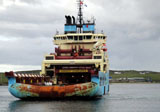
|
The Maersk Laser turning in the harbour basin in order to come starboard side alongside the quay. The stern of
the vessels already looks worn after anchor handling work, where oil rig mooring chains and anchors are pulled up over
the stern roller onto the main deck. The Maersk Laser is also equipped with secondary winches, visible just below the
bridge deck. These are used for storing extra rig mooring cable or rope. |

|
Approaching the quay. The Laser is fitted with a unique prototype anchor handling system on deck, the Remote
Anchor Handling System, developed in a cooperation between Maersk, Rolls Royce and Statoil. The gantry crane hovering
over the main deck with the work "Odim" written on it is part of this system. The gantry is eqipped with two remote
controlled robotic arms which can be controlled from the bridge, theoretically eliminating the need for personnel on
deck during anchor handling work. |

|
Alongside in Lerwick, Shetland Islands. The symbols on the bow, below the lower portholes, indicate that the ship
is equipped with two bow thrusters (sideways propellers). Unlike the Maersk A-class, which are largely similar vessels,
the L-class is not equipped with an azimuth thruster (360 degree revolving thruster). |

|
A view of the starboard side of the accommodation. The L-class have rather large accommodations, with room for up
to 70 people (apart from the regular crew, most in double cabins). During some jobs the ship will need extra manning,
e.g. divers, ROV operators, representatives of the charterer (customer), surveyors etc. |

|
The 3rd Engineer cabin that I occupied during my time onboard. The cabins for the officers are relatively large
on the L-class vessels compared to smaller / older supply ships. The Captain and Chief Engineer have larger cabins
with separate bedroom and day room / office. |

|
Another view of my cabin. The black panel on the wall is the Unmanned Engine Extension Alarm panel. Outside normal
working hours any alarms in the engine room are indicated on duty engineer's panel, giving him 3 minutes to reach the
Engine Control Room and acknowledge the alarm before the alarm goes to the other engineers as well. We were three engineers
on board the Maersk Laser, including the Chief Engineer, so you were on duty every 3rd day. |

|
All officer and crew cabins are equipped with television, stereo and refrigerator. These days all supply vessels
are fitted with satellite television and internet connectivity. |

|
Looking ahead from the aft part of the navigational bridge. 1st Officer is standing at the chart table. The bridge
is usually rather large on modern AHTS vessels, compared to e.g. the much larger container ships. |

|
Conference table in the starboard bridge wing. The radio station is visible in the left side of the picture, with
the chart table to the right of it. Further to the right is the forward control panel from where the ship can be
navigated. |
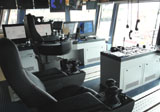
|
Overview of the aft part of the bridge, with the winch control chair in the foreground and the manoeuver chair in
the background. This is where the ship is manoeuvered and the main anchor handling winches operated from during anchor
handling work. Behind the manoeuver chair the two Dynamic Positioning operator stations are visible, a key component in
any modern offshore support vessel. |

|
View from the winch driver's chair. The chair can be moved forward so the winch driver has a good overview
of the main deck. CC TV screens (just visible in top of picture) provide the winch driver with views of the main winches
from various angles allowing him to see the winches during anchor handling. The winch driver also operates the shark
jaws and related hydraulic equipment on deck. |

|
Another view of the aft part of the bridge, here from the port side bridge wing. |

|
The Captain in the manoeuver chair during berthing in Aberdeen, Scotland. The local Pilot stands by to assist. It
is common to manoeuver the ship from the aft bridge console during berthing, since the view of the deck and ship as a
whole is much better from here that from the forward console. Manoeuvering can also be done from the bridge wings, but
this is only rarely seen. |

|
Entering the port of Aberdeen, Scotloand, just about to pass the breakwater. Aberdeen is a busy offshore harbour
on the east coast of Scotland, serving as shipping port for many of the oilfields in the North Sea. During the winter
the breakwater of Aberdeen can be a very welcome sight, signalling a couple of days at rest after maybe weeks of rolling
around on rough North Sea waters. In this particular instance though, the seas were as fair as ever. |

|
The Maersk Supply Service vessels Maersk Attender and Maersk Traveller moored in Aberdeen. The Attender is fitted
with a huge offshore knuckle jib crane for subsea work, with a max capacity in excess of 200 tons. Extra care has to
be taken in terms of ship stability when suspending loads of that magnitude over the side of the ship, and exhaustive
stability calculations are always carried out before undertaking such an endavour. |
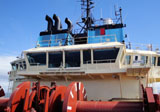
|
A view of the aft part of the accommodation and wheelhouse. The Laser is fitte with secondary winches as seen in
this picture. They are used for storage of wire or polyester rope etc. for varous offshore operations. Like most AHTS
vessels the Maersk Laser is fitted with two funnels, but as is often the case, only one of them actually houses any
exhaust pipes. The "dummy funnel", fitted for aesthetic reasons, is usually used for storage or for housing a
ventilation unit for the bridge. |

|
The North Sea is infamous for its weather conditions, with gale force winds being a common occurrence. The first few days
on board this can be very frustrating, but the body adapts and gets used to the movements of the vessel. Sleeping can be
challenging though which is one of the reasons the assignment period is one week shorter when serving in these waters compared
to the rest of the world (with a few exceptions). |

|
The North Sea at its usual self, with quite a bit of wind and sea. Looking out from the aft bridge you have a good
view of the main deck, critical during anchor handling operations. The Maersk Laser however is fitted with a gantry boom
on the main deck, obscuring part of the view. |
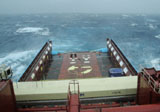
|
If the vessel is standby at an oil rig in weather like this you generally try to keep the vessel heading into or
directly away from the wind and see. This reduces the rolling of the vessel but increases the pitching. The pitching,
however, is generally not felt as much as the rolling. Heading away from the weather with wind and see coming from the
aft typically provides for the most smooth sailing. |

|
Heading straight into the weather, here a Beaufort force 8 gale. The Beaufort scale is a number between 0 and 15 and is
used on ships to categorize weather conditions. 0 on the scale is dead calm and force 15 would be a hurricane. |

|
Here the wind is up to a force 9 on the Beaufort scale, a strong gale. The cargo containers on deck are always
securely lashed (hardly visible in picture) to prevent it from moving about during transport. Loose cargo on a ship is
is a very serious situation, where the shifting weights can impact the ship's stability as well as damage the vessel and
the cargo itself. |

|
|

|
|

|
|

|
|

|
|

|
|

|
|

|
|

|
|

|
|

|
|

|
|

|
|

|
|

|
|

|
|

|
|

|
|

|
|

|
|

|
|
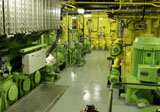
|
|

|
|

|
|

|
|

|
|

|
|

|
|

|
|

|
|

|
|

|
|

|
|

|
|

|
|

|
|

|
|
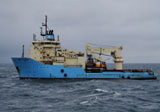
|
|

|
|

|
|

|
|

|
|

|
|

|
|

|
|
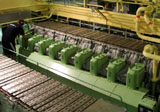
|
|

|
|

|
|
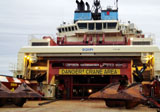
|
|

|
|

|
|
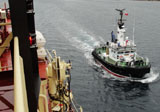
|
|

|
|

|
|

|
|

|
|

|
|

|
|

|
|
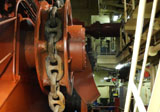
|
|

|
|

|
|

|
|

|
|

|
|

|
|

|
|

|
|

|
|

|
|

|
|

|
|

|
|

|
|

|
|

|
|
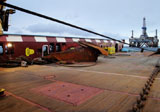
|
|
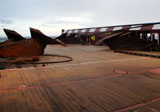
|
|

|
|

|
|
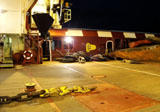
|
|

|
|

|
|

|
|

|
|

|
|
|











































































































